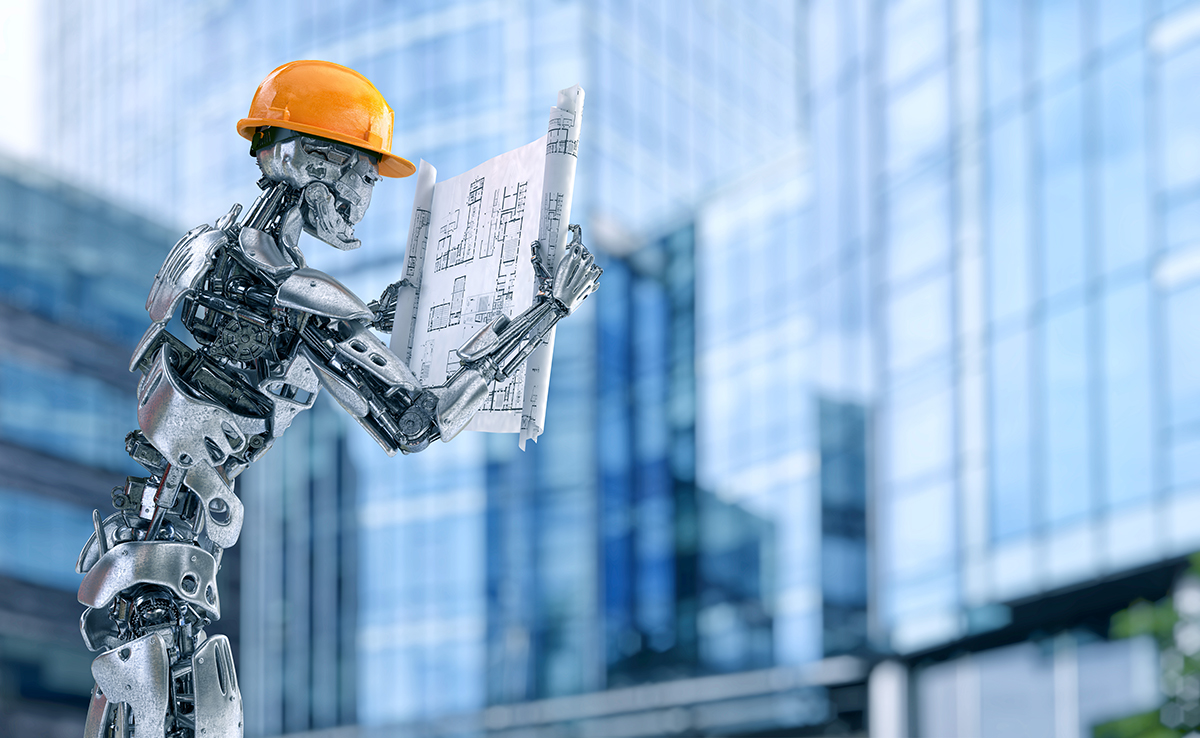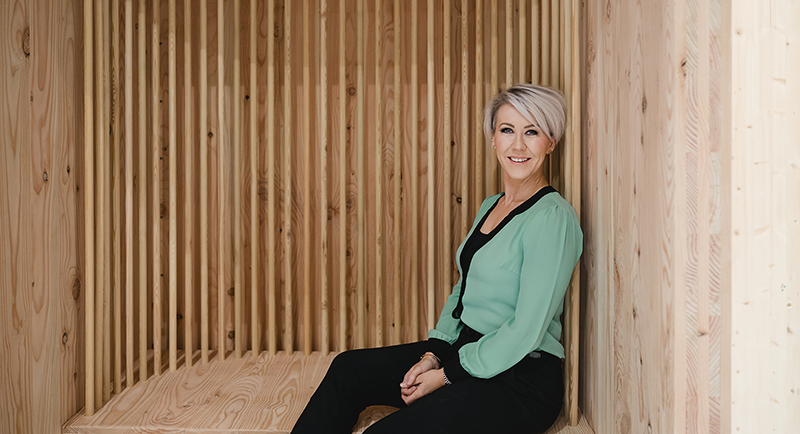
SCOTLAND’S construction industry is broadly enthusiastic about the potential benefits of the growing use of Artificial Intelligence (AI), Project Scotland can reveal.
As the AI ChatGPT phenomenon continues to take the world by storm, a whole series of debates have been sparked around the pros and cons of AI and its increasing use in many aspects of life.
For the construction sector, AI is expected to feature increasingly prominently. But at what cost to the traditional workforce?
Project Scotland asked a range of stakeholders from the construction industry for their views on the use of AI and whether this is something to be welcomed, feared, or potentially a combination of both.
Matthew Paton, associate impact manager – digital at Built Environment Smarter Transformation (BE-ST), told us he sees AI as a ‘hugely important tool’ that will feature heavily in the future of manufacturing and built environment processes. “Large data sets will allow increasingly intelligent decisions to be made – increasing safety and efficiency,” he added. “This is very much a good thing.
“From my perspective, generative AI might shake up the design and visualisation professionals in the workforce. At risk here are the architects, planners and 3D visualisers who may find much of their work being replaced by a simple command. This allows opportunities for these professionals to grow into new fields, such as filling the need that will be created for professional AI prompt writers who are experienced enough to ask the right questions. And, once a design is generated, the professionals may still need to qualify the accuracy or validity of the solution.
“For those on the traditional workforce, AI will not be replacing labour, but may improve efficiencies and safety. Where we need to exercise caution is when dealing with compliance and regulation issues.
“AI systems will make it easier to conform to codes, but increasingly difficult to spot mistakes. Over reliance on an ‘objective’ form of truth may remove the need for final human oversight or supervision. But, if systems aren’t suitably mature or have enough safety built in, this could lead to trouble.”
Andrew Crawford, head of IT business solutions at GRAHAM, said the ‘significant potential’ of AI could offer solutions to challenges such as skills shortages and low productivity. While AI is not a new technology, Andrew believes its recent rapid development and expanded options make it a ‘game-changer’ for the industry’s future.
“At GRAHAM, we are fully committed to leveraging AI in a way that our company needs,” he explained. “To achieve this, we have established a dedicated business intelligence team and are up-skilling individuals to lead AI implementation across our organisation. One notable project involves using AI in facilities management to predict asset failures like boilers. On construction sites, we employ AI to analyse progress against the project schedule. Our site team members wear 360-degree cameras on their hard hats, capturing repetitive images that are stitched together. By utilising AI, this solution provides a completion percentage against the project timeline. Currently, we employ this technology in build-to-rent developments, which benefit from their repetitive design, including our flagship development, PLATFORM_Glasgow, at Central Quay.

“We recognise the potential of AI in areas such as health and safety, where it can analyse images to identify hazards. Solutions already exist for creating ‘safe zones’ for machinery, preventing their operation in hazardous areas. Although the safety zone feature cannot entirely eliminate human error, this innovative technology undoubtedly reduces accidents. Newer generative AI technologies like chatbots and ChatGPT also hold promise as valuable sources of information for our site teams, enhancing efficient and aligned knowledge sharing. This year, we plan to leverage AI to gain insights into our programmes and commercial solutions, helping identify trends.”
Andrew added that the firm strategically evaluates the potential of introducing AI across various business disciplines, focusing on areas where it offers ‘clear benefits and reasons’ for implementation. However, there is also an acknowledgement that the road ahead will present challenges as well as opportunities.
“We must also be mindful of the downsides of AI, particularly in governance and cybercrime,” he continued. “Criminals may exploit AI to develop more sophisticated methods of attacking businesses and individuals, emphasising the need for a security-first mindset when implementing solutions.
“Naturally, there is fear of the unknown, fuelled by reports suggesting that AI has the potential to threaten jobs. While it is true that AI can automate repetitive, administrative tasks, as an industry, we should embrace this as an opportunity to upskill our workforce. By doing so, we can channel their talents into other business areas, addressing the challenges of productivity and skills shortages.”
The Clarus Networks Group is a site connectivity specialist with experience in rapidly deployed high-speed internet solutions for construction and civil engineering projects. Group MD Derek Phillips said that, like many other industries, construction is undergoing a ‘transformative phase’ with the integration of AI.
“Efficient equipment and resource management are crucial for project success, and AI-powered analytics and IoT devices can automate monitoring equipment performance, predicting maintenance needs, and optimising resource allocation. Companies like Caterpillar and Komatsu are already integrating AI into machinery to improve efficiency. AI-driven quality control automates inspections, flags defects, and ensures adherence to design specifications. For example, the use of drones equipped with AI-powered cameras, allows for aerial inspections and 3D modelling. These measures can drastically improve employee safety, reducing the need for manual inspections in potentially dangerous environments.

“AI is only as good as the data it pulls from. To unlock the power of AI, sites also need the right infrastructure in place, including reliable, high-speed internet to connect IoT devices and AI analytics as it happens.
“With clients including Balfour Beatty, BAM, JN Bentley, and Galliford Try, we’ve had great results connecting remote or hard to reach sites using Starlink, a high-speed satellite-based Internet. Using this connection, the site’s AI-driven systems have access to real-time data and cloud-based applications, allowing them to collaborate seamlessly. When a site has their people, AI-enabled machinery and data all working together in real time, this leads to the biggest impact on both project efficiency and site safety.”
Fiona Hodgson, chief executive at SNIPEF (the Scottish and Northern Ireland Plumbing Employers’ Federation), told Project Scotland she believes AI has the potential to reshape Scotland’s construction industry, including its plumbing and heating profession. However, she wants to see the digital transition managed ‘responsibly’ to balance economic advancement with social impact, as the EU competition chief, Margrethe Vestager, recently highlighted.
“From SNIPEF’s perspective, AI, like all technological advances, offers the potential to deliver ever-greater efficiency, precision, and safety to our profession,” Fiona said. “Yet, I also acknowledge the legitimate concerns regarding job displacement, data privacy, and potential misuse.

“Currently, the implementation of AI within our member companies is limited. Some have adopted intelligent technologies and AI-driven tools to streamline their administrative tasks. I suspect that the use of AI in areas such as project planning, resource allocation and just-in-time inventory management will soon become more widespread in SNIPEF member companies, as they will throughout construction.”
Fiona anticipates seeing a ‘gradual integration’ of AI across the plumbing and heating profession, with key factors guiding the transition including cost-effectiveness, availability of training, proven tangible benefits to companies seen from early adopters, and the regulatory landscape.
Rudolph van Wyk, a director at construction and property consultant Thomas & Adamson, sees AI as something to be welcomed overall, with the benefits outweighing the risks.
“At the end of the day, the Thomas & Adamson business is about selling our time and expertise,” he explained. “If a new AI tool can increase productivity by automating manual tasks it is beneficial both for us and our clients.
“We are currently exploring the use of specialised AI tools to streamline efficiencies in the business, but we are yet to widely implement them. Ultimately, combined with our expertise, it undoubtedly has the potential to revolutionise our approach to construction projects.
“As a business, we are continually trying to push boundaries and we view construction specific AI tools as not replacing but enhancing the human side of our business across all disciplines, such as project management and quantity surveying. However, I believe there is an opportunity here which cannot be missed – if you fall behind now, you’ll struggle to catch up!”

Rudolph added that the real benefits will come as AI tools specific to construction are developed, increasing productivity. “For example, we are already seeing systems which can analyse bill of quantities by pulling out the key figures and statistics. Normally, this is a time intensive job which takes up many man hours – with new AI tools it can take just a few seconds, which would then allow us to spend time in a more valuable way.”
Rudolph admitted, however, that as with any new technology there are some unknowns which cause a degree of concern. One that stands out with AI is the secure use of data.
“Lots of the data and information which we use day to day is confidential,” he said. “AI tools must be able to keep this information confidential or else we could inadvertently break legal agreements or be sharing business sensitive data with our competitors. We must also ensure the human element remains at the heart of the business. AI tools are not perfect – they often produce incorrect or, in some cases, totally fabricated information. We must always ensure that information is accurate and sometimes a human can be better at this.
“The overwhelming narrative around AI is that it will take peoples jobs but personally I do not believe that this will be the case. AI is a tool which will be increasingly used but ultimately the need for human input is not going to disappear anytime soon. However, we will see a shift toward training employees on how to make the best use of these emerging tools and possibly the creation of new roles such as AI champions.”
Jennifer Phin, MD at A.C. Whyte, described AI as something to be ‘welcomed with consideration’, emphasising the importance of considering the consequences for anyone who may interact with it. “AI should not be feared, it is inevitable and here to stay,” she said. “Instead, we must embrace it with an open mind to truly understand the risks and opportunities, and effectively manage its impact.”
A.C. Whyte is currently utilising AI in various forms. The company has implemented Large Language Models (LLMs) and integrated AI capabilities in smartphone applications. The contractor is also leveraging AI-powered Microsoft tools, presentation tools and gaining insights through Office 365.
Jennifer added that the business is keen on expanding its utilisation of AI. “However, one of the key factors that would influence our decision is collaborating with experts who possess a deep understanding of AI,” she revealed. “While we may not be AI experts ourselves, it is crucial to align our efforts with professionals who can help us address specific business needs effectively.

“The main benefits and opportunities of AI span across all sectors. One of the significant challenges in the construction industry (and many others) is the skills gap. AI can be leveraged as a solution to help bridge these gaps, allowing individuals to focus on more valuable aspects of their roles. By automating certain tasks, AI can enhance productivity, accuracy, and efficiency in construction processes.”
Rather than viewing AI as an ‘enemy’, Jennifer said A.C. Whyte believes in working alongside it. “AI is not a silver bullet, and it requires proper guidance and oversight. It is our responsibility to steer AI in the right direction and course-correct when necessary. By adopting a proactive approach and maintaining a balance between human expertise and AI capabilities, we can ensure that AI serves as a valuable tool in the construction industry.
“We anticipate that the increased use of AI will have a positive impact on the construction workforce. While AI may currently be a buzzword, it is crucial to demystify it and communicate its applications effectively. Addressing the communication gap and simplifying AI concepts will help individuals in the construction industry understand how AI can benefit their roles. By using AI tools as complements to their existing skill sets, individuals can unlock their full potential and deliver enhanced value.”
Jennifer concluded by saying it is essential to foster a culture of continuous learning and upskilling within the industry. “As AI continues to evolve, staying updated with the latest advancements and investing in training programmes will empower individuals to adapt and thrive in a technology-driven environment. Collaboration between industry experts, AI researchers, and construction professionals will further drive innovation and unlock the full potential of AI in construction.”
Les Calder, chief technology officer at Donaldson Group, has seen many technologies heralded as the next industrial revolution, but said AI is the first one in 20 years that could have a ‘ground-breaking’ impact on the construction industry – and life in general.
“It is as yet unregulated, and this presents the biggest risk in terms of what is developed and who uses it for what nefarious purpose,” he said. Les added that it also opens the door to new possibilities, with AI starting to create architectural drawings based on a description or selection of images a client likes. Mood boards can be created in seconds and recreated seconds later if a client does not like it.
“We already use (AI) as part of existing apps – mainly on the data security side of things,” Les stated. “However, we are now exploring the capabilities of NVIDIA’s new GPT plug-in released this month, that can create 3D models from descriptions – most crucially using a limited library of components and textures that we can manufacture. It’s very early days, but it could in time dramatically reduce the design phase for our interiors business.

“The main factor allowing us to now explore AI is that third party software manufacturers are starting to create plug-ins for apps, such as ChatGPT, that are open for us to use. NVIDIA is just one example of this, and week by week more are coming.”
In terms of the main benefits and opportunities, Les added, “Design process can soon be automated. This will dramatically shorten the timeframe from customer requirement to CAD drawings, to 3D models, to manufacturing instructions for automated lines. It is a threat to the design industry and sadly a threat to creativity itself, but it will make a huge impact.
“AI can enable much smarter robotic assistance on the construction site, and this is particularly useful where AI can understand rough terrain, and react to a non-static, changing environment. Cranes, plant equipment and even labourers could be replaced by AI controlled robots in 5-10 years.”
Les said the lack of government regulation means that we, as an industry, should try to bring in our own guidelines on the use of AI. He admitted that putting people out of a job will ‘undoubtedly’ be the fear around AI but, managed properly, could offer a lot of opportunities.
“Although AI might take over office tasks, like planning and logistics, as well as developing some creative ideas – we can never fully remove the need for human interaction. While AI takes on these tasks, rather than removing jobs, it frees up capacity to allow people to do more value-added tasks. There is also an opportunity here, while AI is still new, for people to learn and develop skills so they know how to get the most out of it. Keeping on top of the changes and learning how to manage the technology will be crucial to stay ahead.
“AI also takes outsourcing and off shoring to another level. For example, could a Chinese firm realistically manage a UK project fully remotely in five years’ time? Suddenly the competitive landscape is huge.”
Les’s colleague Rod Allan, MD of Donaldson Timber Systems, said AI is something to be used as an advantage rather than a threat.
“I think AI is certainly something we need to know more about, but if it can be regulated and used in the right way, I can see how AI offers opportunities for improved productivity and efficiencies, especially with a dwindling labour pool,” he stated. “It should be a tool to allow our employees to focus on the exceptions rather than the run of the mill tasks – the things that take creativity and problem solving that don’t follow a recipe.
“For the timber frame industry, there are real opportunities in the design process of manufacturing. We’re not looking for creative flair as we’re producing a system, so I can see how we could use AI to automate the design process, do the ‘grunt’ work and allow skilled designers to sign off.
“When it comes to trusses and timber frame structures, our clients are looking for accuracy and standardisation. AI could offer this, along with increased efficiencies, as well as providing a solution to the skills shortage.
“While there will inevitably be a concern about AI replacing jobs, it really needs to the seen as an enabler; allowing people to concentrate on more interesting and diverse activities, while leaving the repeat, formula-based tasks to be taken care of automatically. I’m sure there will also be opportunities for AI to be used to check workmanship based on best in class, which will improve standards across the board.”
Riccardo Giovanacci, MD of Newton Letting, explained that technology is the main driver in the letting industry. However, he stressed that AI can never replace the personal approach.
“I’ve always pushed my team to get on the phone or meet in person to ‘properly’ interact with someone,” he stated. “AI can’t do that. It will never offer you the ‘personal touch’.

I’m sure AI will be able to go what we all do the letting industry more efficiently, but it will never compete with a human in terms of offering empathy or explaining something from experience. Technical advances are great, but they will be at the cost of people’s jobs in our industry and eventually the death.”
Ewan Proctor-Mason, associate at architecture and urban design studio HAUS Collective, said that while it is early days for AI, as a movement the practice expects it to continue developing at pace.
“AI is a powerful and versatile technology, and a technology that we believe can serve to enhance, not replace, our role as architects,” he added. “We acknowledge the potential benefits AI presents in generating data-driven insights informing design and the subsequent influence this may have on our creativity and innovation in design development.

“AI does, however, pose some challenges, such as ethical dilemmas, data privacy, human-AI collaboration, and social and environmental impacts. We believe, therefore, that whilst presenting critical feedback and analysis on the technical performance of buildings, the processing of AI-generated information relies upon human judgment, particularly when developing design solutions, both artistic and contextual considerations, crafting our current and future built environment.”
Sara Ann Logan, VP of design at Volumetric Building Companies (VBC), believes the implementation of AI must be considered within the wider context of the construction sector and process, and with an ‘appropriate level of caution’.
“AI is being embraced by a number of industries and we have an opportunity to embrace the new technology that can create even greater efficiencies in our processes and further increase the quality and reliability of our building solutions,” she said. “We have a global housing crisis unlike anything we have seen before – if integration of AI allows us to make a dent in this crisis, then we really must embrace it.
“There are opportunities for AI at all stages of the construction process. From planning and regulations to compliance, documentation, automation of manufacturing, transport, and construction and through to post-construction and building occupancy monitoring. We also see opportunities in market research and marketing.
“There is a tendency for the construction industry to be slow to adapt to innovations in new technology. It is important for our sector to analyse and determine both the positive and any potential negative impacts that AI can have on the value stream and embrace the opportunities for improvement.”
Sara Ann described the outlook for the construction workforce as ‘alarming’, citing research predicting the sector in the UK alone will need an extra 950,000 workers by 2030. “If embracing AI gives us the opportunity to close this gap, then the construction industry should integrate AI-related solutions wherever possible,” she concluded.








